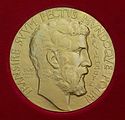John Griggs Thompson
 | |
| Państwo działania | |
|---|---|
| Data urodzenia | |
| profesor nauk matematycznych | |
| Alma Mater | Yale University |
| Doktorat | |
| nauczyciel akademicki | |
| uczelnia | |
John Griggs Thompson (ur. 13 października 1932 w Ottawa Country, Kansas[1]) – amerykański matematyk, ceniony za pracę w dziedzinie teorii grup skończonych[2].
Życiorys
W 1955 Thompson ukończył Yale University[2][3], a w 1959 na University of Chicago obronił doktorat[2][3] pod tytułem A Proof that a Finite Group with a Fixed-Point-Free Automorphism of Prime Order is Nilpotent[3]. W swym doktoracie rozwiązał pewien problem matematyczny, który pozostawał otwarty przez ponad 60 lat[3]. W owym czasie to osiągnięcie zostało dostrzeżone nawet przez The New York Times[4].
John Thompson jest powszechnie rozpoznawalny z powodu udowodnienia w 1963 roku wraz z Walterem Feitem twierdzenia mówiącego, iż każda skończona grupa prosta, która nie jest cykliczna, ma parzysty rząd[2][3] (tzw. twierdzenie Feita-Thompsona). Oryginalny dowód twierdzenia składał się z ponad ćwierć tysiąca stron[2][3]. Naukowcy mieli problem z opublikowaniem swojego dowodu – z powodu jego długości kilka renomowanych czasopism naukowych odrzuciło artykuł[3]. Opublikowali cały kilkusetstronicowy dowód w Pacific Journal of Mathematics[3].
Uznaje się, że rewolucyjne twierdzenie Feita-Thompsona natchnęło matematyków z całego świata do stworzenia klasyfikacji skończonych grup prostych[2][3], której dowód zajął ponad 10 000 stron[2].
Nagrody
Thompson zdobył najwyższe wyróżnienia matematyczne:
- 1970: Medal Fieldsa – za odkrycia w zakresie teorii grup skończonych[2];
- 1984: Medal Sylvestera[5];
- 1992: Nagroda Wolfa w dziedzinie matematyki;
- 2008: Nagroda Abela – za głębokie osiągnięcia w algebrze abstrakcyjnej, zwłaszcza w kształtowaniu współczesnej teorii grup[2].
Przypisy
- ↑ Thompson John Griggs, [w:] Encyklopedia PWN [online] [dostęp 2021-10-11].
- ↑ a b c d e f g h i John Griggs Thompson, [w:] Encyclopædia Britannica [online] [dostęp 2022-09-30] (ang.).
- ↑ a b c d e f g h i J. J. O'Connor,E. F. Robertson, John Griggs Thompson
- ↑ http://www.cecm.sfu.ca/organics/papers/lam/paper/html/NYTimes.html New York Times article, April 26, 1959.
- ↑ Royal Society Sylvester Medalists [dostęp 2014-03-02].
Linki zewnętrzne
 John J. O'Connor; Edmund F. Robertson: John Griggs Thompson w MacTutor History of Mathematics archive (ang.)
John J. O'Connor; Edmund F. Robertson: John Griggs Thompson w MacTutor History of Mathematics archive (ang.)
Media użyte na tej stronie
The flag of Navassa Island is simply the United States flag. It does not have a "local" flag or "unofficial" flag; it is an uninhabited island. The version with a profile view was based on Flags of the World and as a fictional design has no status warranting a place on any Wiki. It was made up by a random person with no connection to the island, it has never flown on the island, and it has never received any sort of recognition or validation by any authority. The person quoted on that page has no authority to bestow a flag, "unofficial" or otherwise, on the island.
The photo carries no copyright and may be freely used for publications. IMU requests, though, that Stefan Zachow's authorship is duly acknowledged. This is the medal that was declined in 2006 by en:Grigori Perelman for his work on the en:Poincaré conjecture. Source: The International Mathematical Union (with more detailed information about copyright at an image description page there)
Obverse of the United States National Medal of Science







